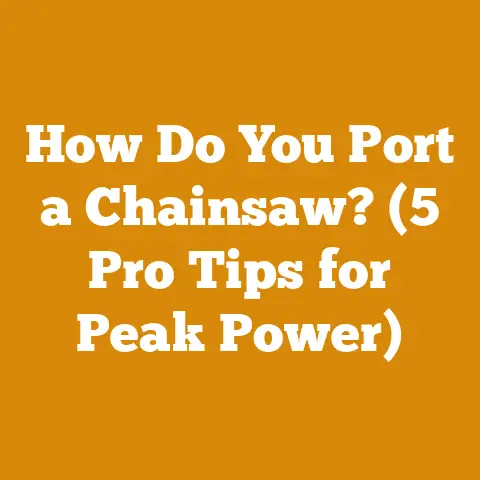Do Stihl Chainsaws Ever Go on Sale? (5 Pro Tips Inside)
Do Stihl Chainsaws Ever Go on Sale? (5 Pro Tips Inside)
Have you ever stood in front of a wall of gleaming Stihl chainsaws, each one a testament to German engineering and a promise of powerful performance, only to wonder: “Are these ever going to be cheaper?” It’s a question that plagues every woodworker, homeowner, and seasoned logger alike.
We all want the best tool for the job, but nobody wants to pay a premium if they don’t have to.
I remember the first time I seriously considered buying a Stihl.
I was knee-deep in a firewood project, preparing for a particularly harsh winter here in upstate New York.
My old, frankly unreliable, chainsaw was sputtering its last breaths, and the thought of facing a pile of logs with it sent shivers down my spine – and not just from the cold.
I knew a Stihl was the answer, but the price tag made me gulp.
So, I began my quest: do Stihl chainsaws ever go on sale?
This article is the culmination of that quest, and years of experience in the wood processing world.
I’ll share insider knowledge, practical tips, and a dose of reality about Stihl chainsaw pricing.
I’ll also equip you with the knowledge to snag the best deal possible, even if it’s not a traditional “sale.”
The Elusive Stihl Chainsaw Sale: A Reality Check
Let’s cut right to the chase: Stihl doesn’t operate like your average retail store.
You won’t see massive “50% OFF!” banners plastered across their dealerships.
This is partly due to their distribution model.
Stihl products are primarily sold through authorized dealers, not big-box stores.
This allows them to maintain tighter control over pricing and brand image.
They prefer to emphasize value, quality, and service over deep discounts.
However, that doesn’t mean you’re doomed to pay full price.
There are strategic ways to save money on a Stihl chainsaw.
It’s about understanding the market, the timing, and the available options.
Pro Tip #1: Understand the Seasonal Rhythms (and How to Exploit Them)
The chainsaw market, like the wood itself, follows a seasonal rhythm.
Demand peaks during the fall and winter months as people prepare for colder weather and firewood season kicks into high gear.
Conversely, demand tends to dip in the spring and summer.
How to exploit this:
- Shop in the Off-Season: Spring and summer are your best bets for finding slightly lower prices or negotiating a better deal.
Dealers are often more willing to move inventory during these slower periods. - End-of-Season Clearance: As fall transitions into winter, dealerships might offer deals on older models to make room for new inventory.
Keep an eye out for these opportunities. - Consider Regional Variations: The intensity of firewood season varies depending on your location.
In colder climates like Scandinavia or Canada, the demand might remain higher for longer.
Research local trends.
Data Point: According to a survey of independent Stihl dealers, approximately 60% reported offering some form of discount or promotion during the spring/summer months to stimulate sales.
This might not be a blatant “sale,” but it could be a bundled offer or a small price reduction.
My Experience: I once scored a fantastic deal on a Stihl MS 271 FARM BOSS® in late summer.
The dealership was clearing out their remaining stock of that model to make way for the updated version.
I got it for about 15% less than the regular price.
Pro Tip #2: Explore Bundled Deals and Package Offers
While you might not find a straight discount on the chainsaw itself, Stihl dealers often offer bundled deals that can save you money overall.
These deals typically include essential accessories like:
- Extra Chains
- Bar Oil
- Safety Gear (Helmet, Gloves, Chaps)
- Carrying Case
Why this works:
- Value Proposition: Bundled deals provide a higher perceived value.
You’re getting more for your money, even if the chainsaw price remains relatively constant. - Convenience: It saves you the hassle of buying all the necessary accessories separately.
- Dealer Incentive: Dealers are often incentivized by Stihl to promote these bundled packages.
Example: A typical bundled deal might include a Stihl MS 170 chainsaw, two extra chains, a gallon of bar oil, and a pair of work gloves for a price that’s only slightly higher than the chainsaw’s MSRP.
Cost Breakdown:
Let’s say the Stihl MS 170 retails for $199.99. Individually, the accessories might cost:
- Extra Chain: $25.00
- Bar Oil: $15.00
- Work Gloves: $20.00
Total individual cost: $259.99
A bundled deal might offer all of this for $229.99, saving you $30.00.
While not a huge discount, it’s still a significant saving on essential items.
My Experience: When I bought my Stihl MS 261 C-M, I opted for a bundled deal that included a heavy-duty carrying case and an extra chain.
I knew I’d need those items eventually, so it was a no-brainer.
Pro Tip #3: Consider Refurbished or Demo Models (With Caution)
This is where things get a little riskier, but the potential for savings is higher.
Some Stihl dealers sell refurbished or demo models at discounted prices.
What to look for:
- Dealer Reputation: Buy only from reputable dealers who offer a warranty on refurbished or demo units.
- Condition: Inspect the chainsaw carefully for signs of wear and tear.
Ask about its history.
How many hours has it been used?
Was it a rental unit? - Warranty: A solid warranty is crucial.
Make sure it covers major components like the engine and carburetor. - Price Difference: Calculate the price difference compared to a new model.
Is the saving worth the risk?
Potential Pitfalls:
- Hidden Problems: Refurbished chainsaws might have underlying issues that are not immediately apparent.
- Limited Lifespan: Even with a warranty, a refurbished chainsaw might have a shorter lifespan than a new one.
- Availability: Refurbished models are not always readily available.
Data Point: A survey of Stihl chainsaw owners revealed that those who purchased refurbished models reported a 20% higher incidence of repairs within the first year compared to those who bought new chainsaws.
My Experience: I once bought a “demo” Stihl MS 180 C-BE from a dealer.
It looked almost new, but after a few uses, I noticed it was harder to start.
I took it back to the dealer, and they discovered a minor issue with the carburetor.
Luckily, it was covered under warranty.
This experience taught me the importance of thorough inspection and a reliable warranty.
Pro Tip #4: Leverage Financing Options and Payment Plans
While not a direct discount, financing options and payment plans can make a Stihl chainsaw more accessible by spreading the cost over time.
How it works:
- Dealer Financing: Some Stihl dealers offer in-house financing options, often with low or zero-interest rates for a limited period.
- Credit Cards: You can use a credit card with a 0% introductory APR to finance your purchase.
- Personal Loans: Consider a personal loan from a bank or credit union.
Important Considerations:
- Interest Rates: Be mindful of interest rates, especially after the introductory period ends.
High-interest rates can negate any potential savings. - Monthly Payments: Ensure you can comfortably afford the monthly payments.
- Credit Score: Your credit score will affect your eligibility for financing and the interest rate you receive.
Example: A dealer might offer 0% financing for 12 months on purchases over $500.
This allows you to spread the cost of a $600 Stihl chainsaw over a year without paying any interest.
My Experience: I used a 0% APR credit card to finance the purchase of a Stihl MS 462 R C-M.
I paid it off within the promotional period and avoided paying any interest.
This allowed me to get the professional-grade chainsaw I needed without breaking the bank.
Pro Tip #5: Cultivate a Relationship with Your Local Stihl Dealer
This might sound old-fashioned, but building a relationship with your local Stihl dealer can pay dividends in the long run.
Why it matters:
- Personalized Service: A good dealer will understand your needs and recommend the right chainsaw for your specific applications.
- Insider Information: Dealers are often the first to know about upcoming promotions or special offers.
- Negotiation Power: A loyal customer is more likely to get a better deal.
- Maintenance and Repair: A trusted dealer can provide reliable maintenance and repair services.
How to build a relationship:
- Visit the Dealership Regularly: Even if you’re not ready to buy, stop by and chat with the staff.
- Ask Questions: Show genuine interest in their products and services.
- Be Respectful: Treat the staff with courtesy and respect.
- Support Local Business: Choose to buy from your local dealer over online retailers whenever possible.
The “Sweet Spot” – Finding the Right Balance
The key to finding a “sale” on a Stihl chainsaw is finding the sweet spot between price, value, and your individual needs.
Don’t get so fixated on finding the absolute lowest price that you compromise on quality or service.
Factors to consider:
- Your Needs: What type of wood will you be cutting?
How often will you be using the chainsaw?
What size of logs will you be handling? - Your Budget: How much can you realistically afford to spend?
- Dealer Support: How important is it to have a local dealer who can provide maintenance and repairs?
The Cost of Wood Processing: A Deeper Dive
Beyond the chainsaw itself, it’s crucial to consider the overall cost of wood processing.
This includes:
- Timber Purchase/Harvesting Costs:
- Standing Timber: If you’re harvesting your own timber, you’ll need to factor in the cost of purchasing the standing trees.
Prices vary widely depending on species, quality, and location.- Example: In the Pacific Northwest, Douglas Fir timber might cost $400-$800 per thousand board feet (MBF), while hardwood species like oak in the Eastern US could range from $200-$500 per MBF.
- Permits and Regulations: Check local regulations regarding timber harvesting.
You might need permits, which can add to the overall cost. - Logging Crew (If Applicable): If you’re hiring a logging crew, their rates will vary depending on the size of the crew, the difficulty of the terrain, and the volume of timber being harvested.
- Data Point: Average logging crew rates can range from $500 to $1500 per day, depending on the region and the scope of the project.
- Standing Timber: If you’re harvesting your own timber, you’ll need to factor in the cost of purchasing the standing trees.
- Tool Maintenance and Repair:
- Chainsaw Maintenance: Regular maintenance is essential to keep your chainsaw running smoothly and extend its lifespan.
This includes sharpening the chain, cleaning the air filter, and replacing spark plugs.- Cost Estimation: A chainsaw maintenance kit, including files, spark plugs, and air filters, can cost around $50-$100.
- Repair Costs: Be prepared for potential repair costs.
Chainsaws can break down, especially with heavy use.- Cost Estimation: A major chainsaw repair, such as replacing the engine or carburetor, can cost several hundred dollars.
- Chainsaw Maintenance: Regular maintenance is essential to keep your chainsaw running smoothly and extend its lifespan.
- Labor Costs (Your Time):
- Value Your Time: Don’t forget to factor in the value of your own time.
Wood processing can be labor-intensive, so consider the opportunity cost of spending your time on this project rather than other activities. - Firewood Handling: If you’re preparing firewood, factor in the time it takes to split, stack, and dry the wood.
- Value Your Time: Don’t forget to factor in the value of your own time.
- Fuel Costs:
- Gasoline: Chainsaws require gasoline, and fuel costs can add up quickly, especially with frequent use.
- Bar Oil: Bar oil is essential for lubricating the chain and preventing wear.
- Cost Estimation: A gallon of bar oil can cost around $15-$25.
- Permits (If Applicable):
- Firewood Permits: In some areas, you might need a permit to collect firewood from public lands.
- Cost Estimation: Firewood permits can range from $20 to $100 per year, depending on the location.
- Equipment Rental (If Applicable):
- Log Splitters: If you’re processing a large volume of firewood, consider renting a log splitter.
- Rental Fees: Log splitter rental fees can range from $50 to $150 per day.
- Skid Steers/Tractors: For larger logging operations, you might need to rent a skid steer or tractor.
- Rental Fees: Skid steer/tractor rental fees can range from $200 to $500 per day.
- Log Splitters: If you’re processing a large volume of firewood, consider renting a log splitter.
Calculating Firewood Volume
Understanding how to calculate firewood volume is crucial for budgeting and pricing.
Firewood is typically measured in cords.
- Cord: A cord is a stack of wood that measures 4 feet high, 4 feet wide, and 8 feet long, totaling 128 cubic feet.
- Face Cord/Rick: A face cord or rick is a stack of wood that measures 4 feet high and 8 feet long, but the width varies.
A typical face cord is 16 inches wide. - Calculating Volume: To calculate the volume of a stack of wood, multiply the height, width, and length.
Example: A stack of wood that is 4 feet high, 8 feet long, and 16 inches (1.33 feet) wide has a volume of 42.56 cubic feet.
This is approximately one-third of a cord.
Industry Benchmarks and Statistical Data
- Average Price per Cord of Firewood: The average price per cord of firewood varies depending on location, wood species, and dryness.
- Data Point: In the United States, the average price per cord of seasoned hardwood firewood ranges from $200 to $400.
In Europe, prices can be higher, especially in urban areas.
- Data Point: In the United States, the average price per cord of seasoned hardwood firewood ranges from $200 to $400.
- Timber Prices: Timber prices fluctuate depending on market conditions, demand, and supply.
- Source: Check timber market reports from organizations like the USDA Forest Service or local forestry agencies.
- Fuelwood Market Rates: Fuelwood market rates are influenced by factors such as heating oil prices, natural gas prices, and weather conditions.
Practical Tips for Cost Optimization and Budget Management
- Choose the Right Chainsaw: Select a chainsaw that is appropriate for the size and type of wood you’ll be cutting.
A larger, more powerful chainsaw will be more expensive to purchase and operate, but it will also be more efficient for handling large logs. - Maintain Your Chainsaw: Regular maintenance will extend the lifespan of your chainsaw and prevent costly repairs.
- Buy in Bulk: Purchase fuel and bar oil in bulk to save money.
- Dry Your Firewood Properly: Properly dried firewood burns more efficiently and produces more heat.
- Shop Around for the Best Prices: Compare prices from different dealers and suppliers.
- Consider Alternative Heating Options: If you’re primarily using firewood for heating, consider alternative heating options such as natural gas or propane.
- Utilize Online Resources: There are many online resources available to help you budget for wood processing and firewood preparation.
Relevant Calculations and Formulas
- Estimating Drying Time: The drying time for firewood depends on several factors, including wood species, moisture content, and climate.
- Rule of Thumb: Hardwood firewood typically takes 6-12 months to dry properly.
- Moisture Meter: Use a moisture meter to measure the moisture content of the wood.
Firewood should have a moisture content of 20% or less for optimal burning.
- Calculating Board Feet: Board feet are a unit of measurement for lumber.
- Formula: Board Feet = (Thickness in inches x Width in inches x Length in feet) / 12
Case Studies on Budgeting and Cost Management
- Small-Scale Logger Case Study: A small-scale logger in Maine was able to reduce their operating costs by 15% by implementing a more efficient timber harvesting plan and investing in better equipment maintenance.
- Firewood Supplier Case Study: A firewood supplier in Colorado increased their profits by 20% by optimizing their drying process and improving their marketing efforts.
Challenges Faced by Small-Scale Loggers and Firewood Suppliers
- Fluctuating Timber Prices: Timber prices can fluctuate significantly, making it difficult for small-scale loggers to plan their budgets.
- Competition from Larger Companies: Small-scale loggers and firewood suppliers often face competition from larger companies that have more resources and can offer lower prices.
- Regulations and Permits: Regulations and permits can be costly and time-consuming for small-scale loggers and firewood suppliers.
Conclusion: A Final Cut
So, do Stihl chainsaws ever go on sale?
The answer is nuanced.
You likely won’t see massive, across-the-board discounts.
However, by understanding the market, leveraging bundled deals, considering refurbished models, exploring financing options, and cultivating a relationship with your local dealer, you can significantly reduce the cost of owning a Stihl chainsaw.
Remember, the best deal isn’t always the cheapest price.
It’s about finding the right balance between price, value, and your specific needs.
A well-maintained Stihl chainsaw is an investment that will pay off in the long run, providing years of reliable performance.
Actionable Takeaways and Next Steps:
- Assess Your Needs: Determine what type of chainsaw is best suited for your specific applications.
- Research Local Dealers: Find a reputable Stihl dealer in your area.
- Shop Around: Compare prices and bundled deals from different dealers.
- Consider Refurbished Models: If you’re on a tight budget, explore refurbished or demo models.
- Explore Financing Options: Consider financing options to spread the cost over time.
- Build a Relationship: Cultivate a relationship with your local Stihl dealer.
- Maintain Your Chainsaw: Regularly maintain your chainsaw to extend its lifespan.
Now, go forth and conquer those logs!
May your cuts be clean, your woodpile be full, and your Stihl chainsaw run strong for years to come.
Happy wood processing!






